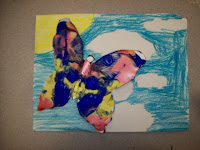Boy have we learned a lot about insectsand definitely become Jr. Entomologists!! We created a schema chart to display what we already knew (or thought we knew) and list any questions we hoped to answer about insects. We made an entomologist journal to store all of the things we would learn and create about insects.
We discovered what defines a creature as being an insect. We learned a song by Dr. Jean to help us learn about the most important characteristics of an insect: 3 body parts (head, thorax, abdomen), 2 antennae, and of course 6 legs. The kids loved this song and sang it any chance they got.
We learned that insects have a set of compound eyes. We used these nifty party favors to help us see the world through compound eyes.
We observed some real insects in the larva stage. These are our mealworms. We will continue to observe them throughout the next 2 stages of their lives. We had some very active little guys who liked running off of our plates! We talked a lot about how to make scientific drawings by drawing exactly what we saw. Even though we think they would look really great with a pink bow or a few rainbow stripes-as jr. entomomologists we had to draw only what we observed. We can't wait to see how they change as they enter the pupa stage. I was very impressed that no one was too squimish to hold or have the little crawlies nearby.
We worked with the chunk -ug this week as well. We wrote and collected -ug words for our bug jug.
We learned so much about life cycles over the course of this unit. I think the kids had an amazing understanding of the 4 main stages of an insect's life. Here is a life cycle craft we created for butterflies.
Some thinking maps for insects we learned about...
We created a brace map to show the parts of the honebee. We found out that bees are really smart! They live very similar to ants. Both are social and the females are the ones we see doing all of the work. Both insects also have a queen who is mom to all of the other ants/bees in the colony. We used pattern block shapes to see how many ways we could fill a hexagon. Hexagons are the shape bees use to create the cells that make up their honeycomb.


We read the book
Hey Little Ant about a boy who gets ready to step on a tiny ant. The ant tries to convince him otherwise. The author leaves us with the boy holding his foot over the ant and asking what he should do. We created this chart to give reasons for both possible responses and then wrote about what we would do. I found this idea on Pinterest from these two blogs:
http://plantspress.blogspot.com/2012/04/ants.html and
http://kindersmarties.blogspot.com/2012/03/going-buggy.html?showComment=1332893830355#c5765969549965766049. I have always loved this book and thought
the craft and chart were absolutely adorable!


On Friday, we made insects using pattern blocks. While working on these the kids came back to make an insect snack. They could use any of the materials (licorice, gum drops, marshmallows, chocolate chips, pretzels) to create an insect, but it had to have 3 body parts, 2 antennae, and 6 legs. Then they had to have a friend check their creation before they could draw what they made and eat it. This was so much fun! I loved seeing all of their creations!! This idea came from Deanna Jump's insect unit.





























































